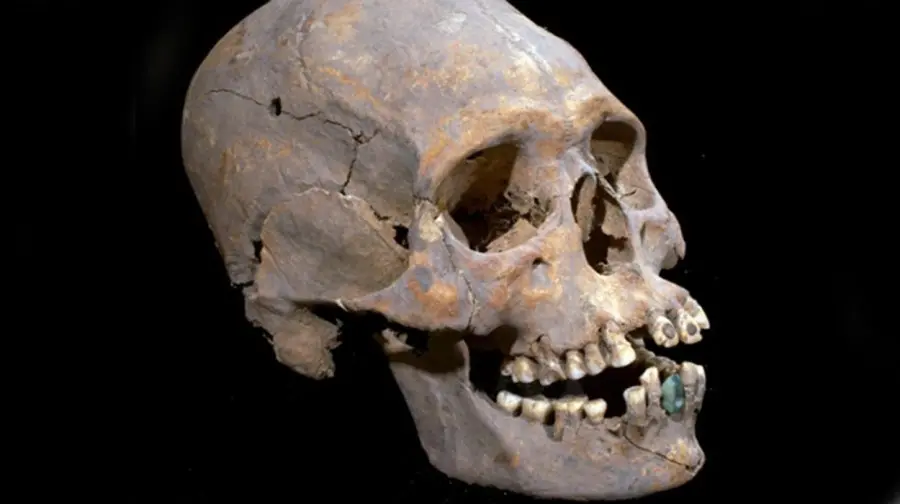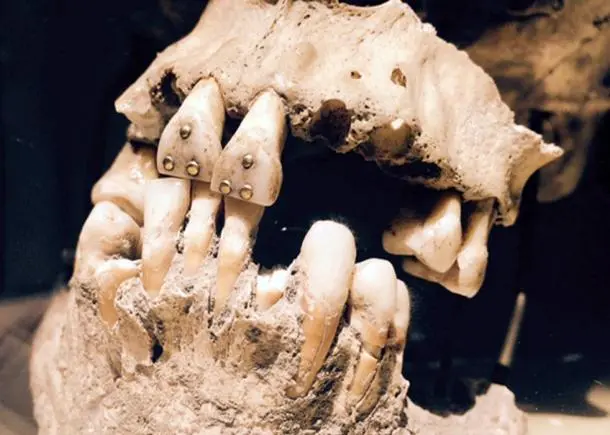Mexico’s Tooth Treasures: Cemetery’s Quiet Hoard
Archaeologists in Mexico have unearthed a remarkable burial at the ancient ruins of Teotihuacan containing a 1,600-year-old skeleton of an upper-class woman with an elongated skull, stone-embedded teeth and a prosthetic tooth made of a green stone known as serpentine. She was buried with 19 offering jars.

Agence France-Presse reported that the skeleton has been named “The Woman of Tlailotlacan” after the neighborhood where it was found, near Mexico’s famous Teotihuacan ruins, which are about 30 miles (50 km) north of Upper Mexico City. Dating back some 2,500 years, Teotihuacan is one of the largest and most important sacred cities in ancient Mesoamerica, its name meaning “city of the gods” in the Nahuatl language of the Aztecs. It once had an estimated population of 100,000 to 200,000 people, who raised giant monuments such as the Temple of Quetzalcoatl and the Pyramids of the Sun and Moon. However, much about Teotihuacan remains unknown, including the origin and language of the people who lived there, as they left no written records.
The National Institute of Anthropology and History (INAH) said the woman, who was between 35 and 40 years old when she died, was a foreigner in the area, given the way her skull had been deformed and her teeth embedded. The stones inside were not usual in that region. The institute said in a statement that her skull had been elongated by compressing it in a “very extreme” way, a technique commonly used in the southern part of Mesoamerica, not in the central region where she was found.
Their teeth contained two round pyrite stones, which were embedded in their upper front teeth. This was a practice that was used among nobility in the Mayan regions of southern Mexico and Central America. The Mayans are credited with being the masters of cosmetic dentistry, as they were known to decorate teeth by inlaying them with precious stones or carving notches and grooves into them. Small holes were cut into the teeth and ornamental stones, including jade, were attached using an adhesive made from natural resins, such as plant sap, which was mixed with other chemicals and crushed bones. Dentists likely had a sophisticated knowledge of dental anatomy because they knew how to drill into teeth without hitting the pulp inside.

Gold-encrusted teeth, pre-Columbian Ecuador.
Last year, archaeologists discovered liquid mercury in an underground tunnel beneath the Temple of the Feathered Serpent at Teotihuacan, which may represent an underworld river leading to a royal tomb or tombs. The remains of the Teotihuacan kings, some of the most powerful rulers in the pre-Hispanic world, have never been found. Such a discovery would be monumental as it would unravel many of the mysteries surrounding this ancient civilization.

A 1,600-year-old female skeleton has been discovered at Teotihuacan, Mexico, revealing a fascinating glimpse into the past. “The Woman of Tlailotlacan” possessed an artificially elongated skull and teeth adorned with pyrite stones, a practice common among Mayan nobility. This suggests she was a foreigner, possibly from southern Mesoamerica. The discovery raises intriguing questions about her status and the cultural connections of Teotihuacan. Was she a royal? What was her story? This mysterious woman’s burial offers a tantalizing clue to unlocking the secrets of this ancient city.






